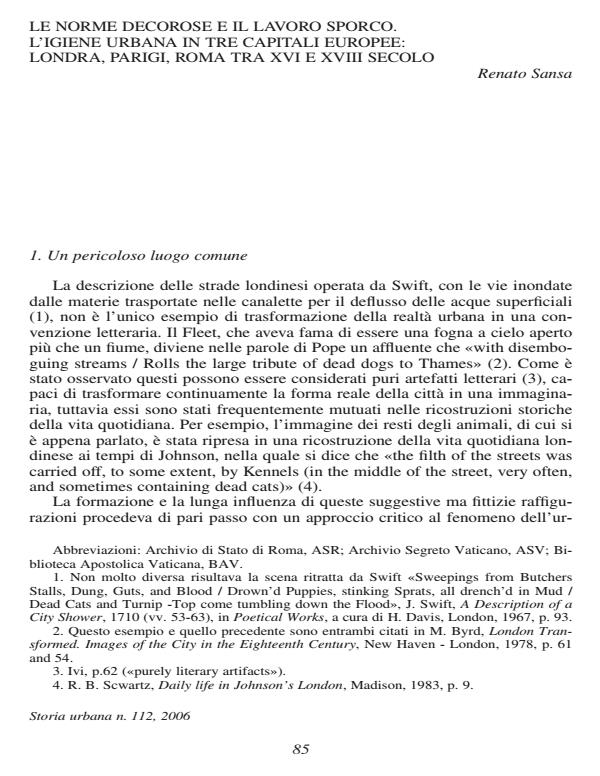Le norme decorose e il lavoro sporco. L'igiene urbana in tre capitali europee: Londra, Parigi, Roma tra XVI e XVIII secolo
Titolo Rivista STORIA URBANA
Autori/Curatori Renato Sansa
Anno di pubblicazione 2007 Fascicolo 2006/112
Lingua Italiano Numero pagine 28 P. 85-112 Dimensione file 150 KB
DOI
Il DOI è il codice a barre della proprietà intellettuale: per saperne di più
clicca qui
Qui sotto puoi vedere in anteprima la prima pagina di questo articolo.
Se questo articolo ti interessa, lo puoi acquistare (e scaricare in formato pdf) seguendo le facili indicazioni per acquistare il download credit. Acquista Download Credits per scaricare questo Articolo in formato PDF

FrancoAngeli è membro della Publishers International Linking Association, Inc (PILA)associazione indipendente e non profit per facilitare (attraverso i servizi tecnologici implementati da CrossRef.org) l’accesso degli studiosi ai contenuti digitali nelle pubblicazioni professionali e scientifiche
«Monstrous city», «great wen», «painted sepulchre» and other similar expressions were usually adopted to describe European cities throughout early modern history. Defoe in England, Rousseau in France and many others could be quoted as evidence of contemporary concerns about the seemingly uncontrollable city. In contrast to these visions of urban depravity was a sense of smaller communities like the village as a counter-model of sound order and relative sanity. The manner in which such contemporaries conceptualised their social and environmental problems has had a profound influence on the way that modern historians have interpreted the development of towns. Although it’s commonly assumed that the action of early modern city governments was ineffectual to maintain a clean environment, a deeper scrutiny of documentary sources reveal that contemporaries showed an appreciation of the health risk that overcrowding posed. Stench, which according to miasma-humoral theory was believed to be a principal cause of disease, was strictly associated with plague and other illness. Prompted by frequent outbreaks of plague, olfactory vigilance played a central role in regulating towns from the discrimination against poor immigrants and beggars, to the shaping of the city and better sanitation. In this article it will be argued that combating stench was an important task in the mind of municipal governors most notably, to tame plague and its myriads disorder. Despite the close association of urban squalor, filth and disease, frequent complaints about negligence in tackling these problems were made, and, as a result, new institutions and strategies were devised to clean the cities. A comparative study of major European cities (London, Paris, Rome) can help us to better understand how civic sanitation schemes operated in the past, the principal concerns behind these schemes, and the obstructions to their successful implementation.;
Renato Sansa, Le norme decorose e il lavoro sporco. L'igiene urbana in tre capitali europee: Londra, Parigi, Roma tra XVI e XVIII secolo in "STORIA URBANA " 112/2006, pp 85-112, DOI: